
A map detail showing North Staffordshire. Published by Henry Teesdale & Co., London, 1832. (Courtesy, Chipstone Foundation.)
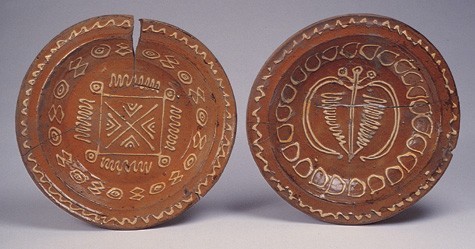
Dishes, Burslem, ca. 1690. Slipware. (Left) D. 13 1/4 ". (Courtesy, Potteries Museum & Art Gallery; photo, David Barker.) These badly warped slipware dishes, recovered from a waste pit in Burslem, are one of the most common types of vessel produced at this time. Almost ninety dishes were found on this site. Very similar dishes have been found at Port Royal, Jamaica, where they were lost during the devastating earthquake of 1692.
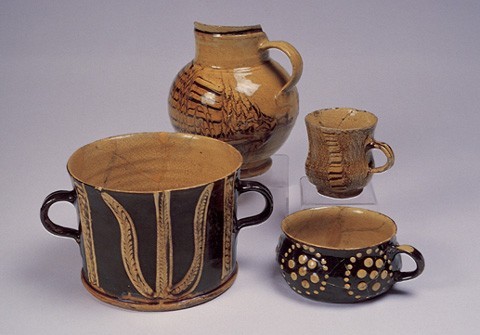
Various vessels, Staffordshire, ca. 1690. Slipware. Two-handled cup. H. 4 1/2". (Courtesy, Potteries Museum & Art Gallery; photo, David Barker.) These slipware vessels excavated from Burslem Market Place (the so-called Sadler’s Site) provide a cross section of typical decorated wares of the late seventeenth century. Drinking vessels predominate, and slip decoration, while commonplace, is generally simple.

Plate, Staffordshire, ca. 1830. Whiteware. D. 4 1/2". (Courtesy, Donald Carpentier; photo, Gavin Ashworth.) The sentiment expressed on this plate from the 1830s, “commerce, The Staffordshire Potteries/And free trade with all the world,” would have been shared by all the Staffordshire manufacturers of the period. This transfer-printed pattern highlights the importance of trade to the survival of the Staffordshire pottery industry.
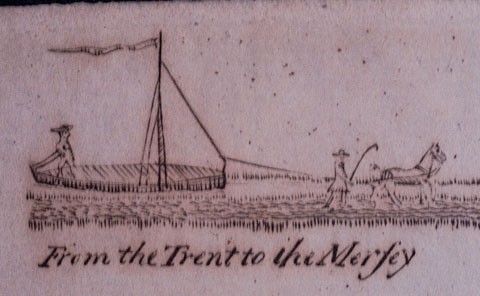
“From the Trent to the Mersey.” Unpublished letterhead, Navigation Office, Stoke, 1800. (John Wood Archives, Potteries Museum & Art Gallery.) The canal, completed in 1777, gave the Staffordshire potteries direct access to the sea. This facilitated an already flourishing trade and significantly reduced the cost of moving raw materials and finished goods.

Archaeological excavation showing large fragments of Staffordshire creamware in a large circa 1780 refuse deposit at a Virginia plantation site. (Photo, Robert Hunter.)
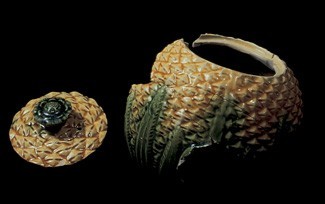
Teapot fragment and lid, Staffordshire, ca. 1770. Creamware. (Photo, Robert Hunter.) An example of a typical Staffordshire product exported to North America.
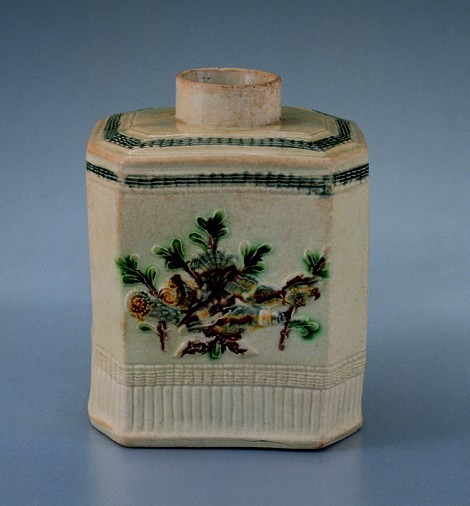
Tea canister, attributed to William Greatbatch, Staffordshire, 1765–1770. Creamware. H. 4 1/4". (Courtesy, Troy Chappell; photo, Gavin Ashworth.)

Biscuit and glazed sherds, Livesley, Powell & Co. and J. W. Pankhurst & Co, Hanley, 1850–1862. Whiteware. (Courtesy, Potteries Museum & Art Gallery; photo, David Barker.) These wares, often called white granite or ironstone china, were excavated in Hanley from a waste dump used by these two local firms.
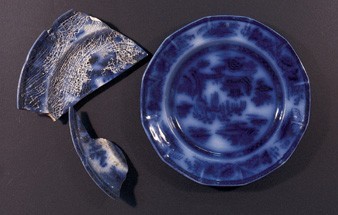
Plate and archaeological fragments, Podmore, Walker & Co., Tunstall, ca. 1845. Whiteware. D. 7 5/8". (Courtesy, Potteries Museum & Art Gallery; photo, David Barker.) This company had extensive trade with North America. Sherds of the pattern “Manilla,” printed in flow blue and recovered from one of the firm’s waste dumps, are shown alongside a finished plate with the same design.
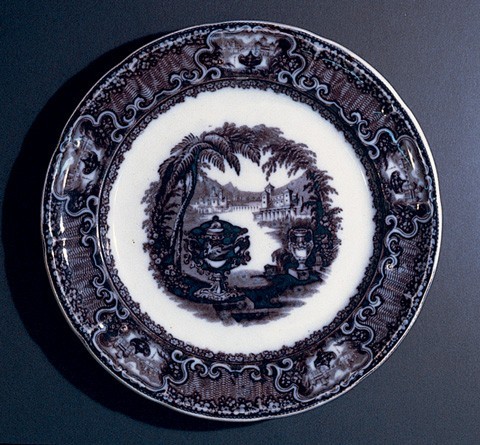
Plate, Podmore, Walker & Co., Tunstall, ca. 1845. Whiteware. D. 9 7/8". (Private collection; photo, David Barker.) This plate is printed in the “Washington Vase” pattern in flow mulberry.
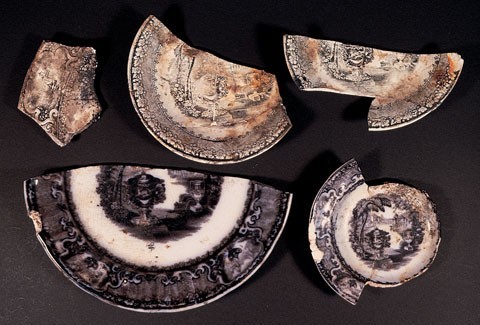
Printed sherds, Podmore, Walker & Co., Tunstall, ca. 1845. Whiteware. Examples of the “Washington Vase” pattern, found in one of the firm’s Tunstall waste dumps. (Courtesy, Potteries Museum & Art Gallery; photo, David Barker.)
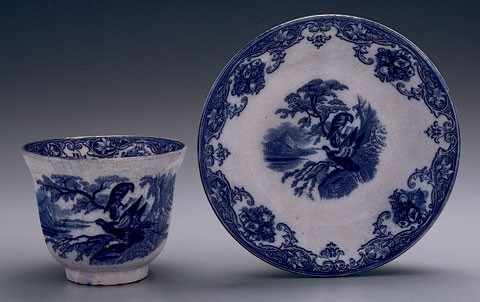
Cup and saucer, Podmore, Walker & Co., Tunstall, ca. 1855. Whiteware. Saucer D. 4 7/8". (Private collection; photo, Gavin Ashworth.) Fragments of the “Eagle” pattern have been recovered from domestic sites in the mid-Atlantic region of the United States.
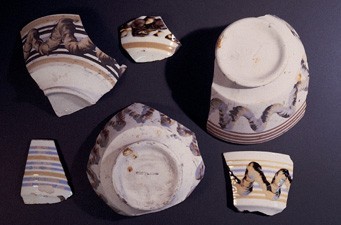
Biscuit and glazed industrial or factory-made slipware waste, Copeland factory, ca. 1850. Whiteware with slip decoration. (Courtesy, Potteries Museum & Art Gallery; photo, David Barker.) These sherds were recovered from a dump adjacent to the Spode factory in Stoke-on-Trent. The sherds are all from “London shape” bowls and are unusual in that they bear the impressed mark “copeland.”
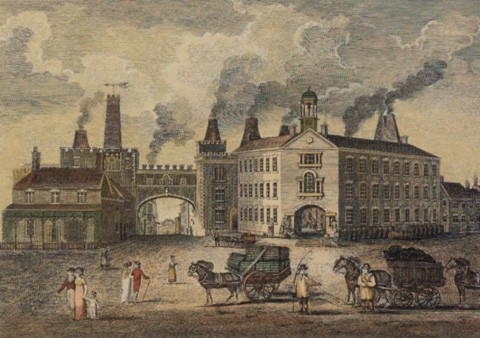
“West view of the manufactory of Messrs. Enoch Wood & Sons—Burslem.” Unknown artist and engraver, 1830–1840. (Courtesy, Chipstone Foundation.) The origin and history of this important print and the print illustrated in fig. 16 are unknown. They may be early proof copies dating to circa 1833. The handwritten titles conflict with later engraved versions, which have the direction information reversed. This view of the entrance of the Fountain Place Works shows a procession of tradesmen’s carts before the elegant façade of the pottery works.
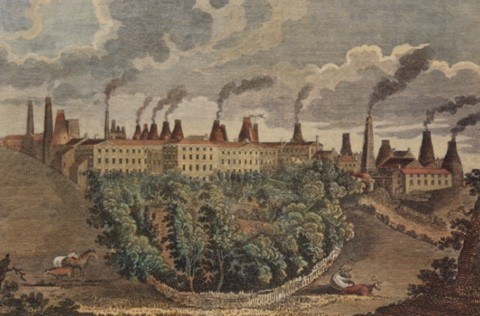
“East view of the manufactory of Messrs. Enoch Wood & Sons—Burslem.” Unknown artist and engraver, 1830–1840. (Courtesy, Chipstone Foundation.) A published version of this view is included in Ward’s History of Stoke-on-Trent (1843). This view shows the extensive arrangement of the pottery works, Enoch Wood’s house, and extensive gardens.

Industrial or factory-made slipwares, Enoch Wood & Sons, Burslem, ca. 1835. Whiteware. (Courtesy, Potteries Museum & Art Gallery; photo, David Barker.) These fragments were recovered from a large town-center waste dump at Burslem Market Place. Although these types of low-priced wares were made by many manufacturers, it is unusual to be able to attribute them to a specific maker. Their discovery here with a mass of marked wares confirms their manufacture by Enoch Wood & Sons, and the archaeological context in which they were found dates them to circa 1835.
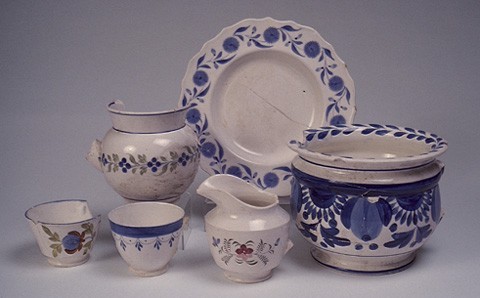
Various painted vessels, Enoch Wood & Sons, Burslem, ca. 1835. Pearlware and whiteware. (Courtesy, Potteries Museum & Art Gallery; photo, David Barker.) Some examples of a wide range of painted earthenwares by Enoch Wood & Sons. These were excavated from the Burslem Market Place waste dump, where they were deposited in circa 1835.
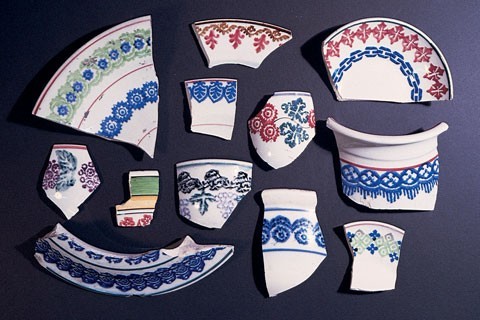
Sponge-decorated sherds, probably from William Baker & Co., Fenton, ca. 1860. Whiteware. (Courtesy, Potteries Museum & Art Gallery; photo, David Barker.) Increasing quantities of archaeologically recovered sponged wares now highlight the importance of these cheap wares from the Staffordshire pottery industry and its export trade.

Sherds, James Edwards, Fenton, 1875–1890. Whiteware. (Courtesy, Potteries Museum & Art Gallery; photo, David Barker.) A selection of late-nineteenth-century wares made for export and excavated in the vicinity of James Edwards’s King Street Works. The “Royal” pattern, the subject of a lawsuit over copyright infringement, appears in the sauceboat base shown in the bottom center image; an unclear impressed diamond registration mark is probably for 1877.
In 1760 the north Staffordshire Potteries[1] were a major force on the world market. By 1850 they were dominant, with Staffordshire wares dictating trends in consumer behavior from North America to Australia and influencing pottery manufacture throughout much of Europe and North America. Documentary sources, and the evidence of a multitude of surviving pieces, are the traditional means of learning about the industry and its development, but increasingly archaeological investigation is contributing a new dimension to research. Recent archaeological excavation in Stoke-on-Trent has resulted in important discoveries that promise an exciting future for the study of ceramics.
Nearly a century ago, Arnold Bennett painted a literary portrait of Staffordshire’s potting industry:
you cannot drink tea out of a teacup without the aid of the Five Towns;... you cannot eat a meal in decency without the aid of the Five Towns. For this the architecture of the Five Towns is an architecture of ovens and chimneys; for this its atmosphere is as black as mud; for this it burns and smokes all night, so that [it] has been compared to hell;...for this it exists—that you may drink tea out of a teacup and toy with a chop on a plate. All the everyday crockery used in the kingdom is made in the Five Towns—all, and much besides....[W]henever and wherever in all England a woman washes up, she washes up the product of the district;...whenever and wherever in all England a plate is broken the fracture means new business for the district.[2]
This 1908 description of the importance of the thinly disguised Six Towns of Stoke-on-Trent is clear. Even when allowances are made for the author’s license in this work of fiction, and even when it is remembered that pottery has always been made in other parts of Great Britain, the dominant place of the north Staffordshire pottery industry must be admitted. The growth of this industry was rapid, corresponding to the increased consumption of its products within Britain, Europe, North America, and beyond. It should be obvious, therefore, that a thorough knowledge of this industry and its products is central to understanding ceramic consumption in the American context.
Yet the study of the Staffordshire industry and its products remains fragmented and frequently lacks academic rigor. The tradition of connoisseurship, for example, remains strong, with its emphasis upon the classification of wares, on the basis of style and decoration, into groups that clearly have no relationship to the context in which they were produced or consumed. The dominant theme of that type of ceramic study, whether dependent upon stylistic comparison or documentary research, is attribution or “who made what?”
Of course this approach can be very helpful, and properly constructed factory product profiles are useful for determining factory-market relationships, the chronology of ceramic development, and the degree of interaction between producers. In some cases, the factory of origin was significant to the consumer, Wedgwood being the obvious example. But this was the exception. In the main, this obsession with the products of individual factories has led to the perpetuation of myths surrounding manufacture, manufacturers, and the importance of their products, and has detracted from the full potential of the subject.
This approach has also detracted from a real appreciation of the process of industrialization within ceramic manufacture, and of both the true nature and the significance of the Staffordshire industry. Relatively minor factories have always attracted more than their fair share of scholarly attention. The Leeds factory, an important producer of creamwares and other ware types in the eighteenth century, is a case in point, being credited today with an impossible number of creamwares for the size of the factory and the duration of its production.
In the 1970s it was believed, perhaps wrongly, that a creamware factory had existed in the 1770s at Melbourne in Derbyshire. Numerous attributions to the Melbourne creamware factory resulted. Bovey Tracey in Devon is the creamware factory presently attracting attributions of creamwares and pearlwares. Who knows what the next few years will bring? Emphasis upon factory-focused study has also diverted attention away from other aspects of the ceramic story: the marketing and distribution of wares and their eventual consumption by ordinary people. In short, factory-based research misses the big picture.
So where do the potteries of north Staffordshire fit into this picture, and why are their products so important to an understanding of ceramic development and ceramic use throughout much of the world?
The Staffordshire ceramic industry is important primarily by virtue of its size and the variety of potteries operating there (fig. 1). A unique combination of social and economic factors led to the initial development of pottery manufacture in north Staffordshire, an area that would appear to be one of the least advantageous for the development of an industry dependent upon trade. It was poorly situated for communication, being about fifty miles from the sea and thirty or so miles from the nearest navigable river ports—Bridgnorth on the Severn to the south, Chester on the Dee to the north, Winsford on the Weaver to the west, and Willington on the Trent to the east. Even after the improvements to river navigation in the first half of the eighteenth century, north Staffordshire was not ideally placed to develop either a major internal trade or a significant export trade. Roads, too, were notoriously bad and road transport was frequently a complaint. Despite these major disadvantages, pottery production flourished. Before the end of the seventeenth century, Staffordshire slipwares, mottled wares, and butter pots were being sold throughout much of England (fig. 2). These wares also found their way in great quantities to the English possessions in the Caribbean and North America (fig. 3).
North Staffordshire’s natural resources more than compensated for its disadvantaged location. Coal and clays of many different types and grades were readily available in the area, enabling good quality wares to be made cheaply. So cheaply in fact that, even after the cost of transportation was added, the Staffordshire potters were able to undercut their competitors.
By the beginning of the eighteenth century there were already fifty pottery workshops in the region producing quality wares for a wide market. For that time period, this sizable concentration of manufacturers constituted a major regional industry. By the end of the eighteenth century, however, the industry had been revolutionized and Staffordshire earthenwares and stonewares were dominant in the home market, in much of Europe, and were becoming a major force in North America. Production had increased throughout the century and the north Staffordshire industry had expanded in size, enabling it to deluge world markets with wares. In 1762 there were approximately 150 separate pottery factories employing 7,000 people;[3] by 1800 the number of workers in the industry had risen to between 15,000 and 20,000,[4] a figure that was to increase throughout the nineteenth century.
The diversity and quality of the factories’ products were also on the upswing. White salt-glazed stonewares and refined red earthenwares brought about the all-important break with the past and traditional wares, a development that was to transform the Staffordshire industry after 1720. Thereafter, new wares were constantly added. White salt-glazed stonewares and early cream-colored earthenwares established a significant international demand for Staffordshire ceramics, which itself was to stimulate the growth of the industry.
Creamware’s growing popularity, particularly after Josiah Wedgwood’s successful promotion of this improved ware during the 1760s, guaranteed the industry’s continued success into the nineteenth century, although at the expense of other sectors of the home ceramics industry. In the face of competition from superior quality earthenwares and stonewares from Staffordshire, the delftware or tin-glazed earthenware industries of London, Bristol, Liverpool, Dublin, and Glasgow began a rapid and terminal decline during the final quarter of the eighteenth century.
In other areas of the country, however, the influence of the Staffordshire wares was more beneficial, stimulating rather than undermining production and promoting new manufacturing ventures. Indeed, it can be argued that, as early as the mid-eighteenth century, a considerable proportion of ceramic manufacture within Britain was being driven by the Staffordshire pottery industry.
The growth of manufacture in Staffordshire, with more and more people making their living from pottery production, led to a tremendous concentration of technical and creative talent in the area, giving rise to an industrial infrastructure that supported the pottery factories. This infrastructure included the carriers who imported raw materials and who carried out the finished products, millers who prepared flint and clays for factory use, freelance decorators and engravers, toolmakers and engineers, and the crate makers in whose willow crates the wares were transported.
This concentration of talent was doubtless the reason that many of the most significant technical innovations in ceramic manufacture originated in Staffordshire—or came to be employed there on a grand scale—and that most of the dominant types of eighteenth-century earthenware and stoneware were developed there. White-bodied salt-glazed stonewares may have been introduced first by John Dwight of Fulham in the 1680s,[5]but it was in 1720s Staffordshire that they began their evolution into fine quality wares suitable for the tea tables and dining tables of a large body of the population.
The increased demand for refined earthenwares and stonewares in the eighteenth century encouraged the establishment of factories in many parts of the country, all of which produced Staffordshire-type wares. The production of creamware was begun in Liverpool, Hull, Bristol, Shropshire, London, Bovey Tracey, Sunderland, Newcastle-upon-Tyne, South Wales, at numerous centers in Yorkshire, and in Scotland. While many of these centers came to adopt particular styles of their own, it is clear that north Staffordshire industry set the standard for manufacturing.
At first the influence of the Staffordshire industry was spread by migration of potters. The movement of Staffordshire potters to other parts of the country is well documented from the seventeenth century. Clearly, they took with them well-established techniques and styles of ware that they would continue to manufacture in their new homes.
Staffordshire potters were found producing slipwares in Cumbria from the late 1690s[6] and along the banks of the Severn in Shropshire from the 1710s.[7] Staffordshire potters are documented in Bovey Tracey in the first half of the eighteenth century,[8] in Yorkshire,[9] Newcastle-upon-Tyne,[10] Scotland,[11] and elsewhere in the second half of the eighteenth century. There were also Staffordshire men in London during the early days of porcelain manufacture in the 1740s,[12] and it is likely that they were responsible for bringing the techniques of porcelain manufacture back to their home towns.
This migration continued so that, by the nineteenth century, wherever there was a factory making creamwares, pearlwares, and other dominant fine wares, there were likely to be Staffordshire potters involved in some aspect of the business. This was clearly an important factor in the dissemination of Staffordshire styles and technology, but it alone cannot explain the overwhelming influence of the Staffordshire industry. Rather, the sheer size of the industry and its supporting infrastructure of myriad ancillary trades ensured its dominance.
The nature of production in north Staffordshire, and the comparatively small size of most of its factories, necessitated extensive external support to provide raw materials, tools, and equipment. While the best-known firms of the late eighteenth and nineteenth centuries generally employed in excess of five hundred workers, the vast majority of factories operated with far fewer. As late as 1851, more than 60 percent of the north Staffordshire earthenware factories had a workforce of fewer than twenty.[13] Production on such a scale could not have survived without specialist suppliers for most of its needs. Besides raw materials (clays, flint, glazes, colors, etc.), the smaller factories, financially unable to employ their own engravers, turned to specialist engraving shops for their copper plates. As even fewer factories had the resources to employ their own modelers and block makers, they also used freelance mold makers, who sold block molds to all the factories. It seems likely that during the 1750s and 1760s there were very few modelers operating in Staffordshire, but one of these, Aaron Wood, is documented as a freelancer and was “modeler to all the potters in Staffordshire at the latter end of the time that white stoneware was made.”[14]
The late eighteenth and early nineteenth centuries also saw an increase in the number of engineering companies that specialized in the equipment and machinery used in the pottery industry. By the mid-nineteenth century, there were specialist manufacturers of kiln furniture mass-producing stilts and spurs used to support wares during firing. The presence of these companies ensured that Staffordshire kiln furniture was going to be used by manufacturers throughout Britain and beyond.
Only in Staffordshire did this range of pottery-related expertise accumulate in such abundance. It was inevitable that this expertise would also serve and supply new factories established elsewhere within Britain and abroad. By the end of the eighteenth century these industries were coming to rely upon Staffordshire skills and products in many areas, avoiding the expense of producing their own costly equipment.
The proliferation of specialist suppliers greatly increased the influence of the Staffordshire potteries, and by the end of the eighteenth century Staffordshire-type wares were the industry standard. There was no change during the nineteenth century. Wherever pottery factories were involved in the manufacture of fine earthenware, it was Staffordshire-type wares they produced, using tools and equipment purchased from Staffordshire companies and the manufacturing processes developed there. This influence can be seen at factories as far apart as Bovey Tracey, Plymouth, South Wales, Liverpool, Newcastle-upon-Tyne, and Glasgow, all of which were producing Staffordshire-type wares.
An inevitable consequence of industrialization and developing reliance upon freelance suppliers was the increasing standardization of wares. Product uniformity was a feature from the very outset of industrial-scale production in Staffordshire in the early eighteenth century. The introduction of certain standardized processes, although still very much dependent upon workers’ skills, was essentially the same in all factories. The widespread use of the lathe, for example, reduced the individuality of the thrower and the variations that might occur in throwing. From the 1720s all hand-thrown wares were lathe turned, adding to the uniformity of a factory’s products.
The growing importance of molding as a manufacturing method since the 1740s further reduced the possibility of variation in wares. All vessels made from the same working mold would be identical, as would all working molds made from the same master mold. Because many factories were buying their molds from specialist suppliers, it was unavoidable that specific designs would be commonplace.
In the eighteenth and nineteenth centuries, transfer printing from engraved copper plates also increased the uniformity of decoration by providing potters with a plethora of established patterns, such as Broseley or Willow. It was inevitable that this conformity spread throughout the industry, and that the wares of one Staffordshire factory were largely indistinguishable from those of its neighbors and even those of its more distant competitors. The wares illustrated in the catalogs of the Leeds, Whitehead (Hanley), Don (Doncaster), and St. Anthony’s (Newcastle-upon-Tyne) potteries are, for example, virtually interchangeable.
A consequence of this was that the practice of in-trading between factories became commonplace, buying-in wares from neighbors to fill orders. This could only have happened in an industry whose products were identical. There is ample evidence for this practice of dealing between factories from an early date (and indeed, it is still a normal part of the pottery business today).
In the 1750s and 1760s, for example, John and Thomas Wedgwood, then the largest potters in Burslem, bought wares from more than twenty local manufacturers, while selling to fifty.[15] John and Thomas’s more famous second cousin, Josiah Wedgwood, conducted business in much the same vein, buying-in wares from at least fifty other factories.[16] One of the better known of these is the factory of William Greatbatch of Fenton.
Greatbatch’s well-documented dealings with Wedgwood can be viewed from both historical and archaeological perspectives, following the excavation of his factory’s waster dump. Detailed records show that in just over two years, from December 1762 to January 1765, Wedgwood bought more than 560 crates of wares, the equivalent of almost a quarter of a million pieces, from Greatbatch.[17] This was no small trade either for Greatbatch or for Wedgwood.
The situation could not, therefore, be more complicated for the student of ceramics interested in attribution. Not only did factories buy their molds and copper plates from central suppliers, they also had access to molds, plates, and other tools and equipment from the sales that followed the all-too-frequent bankruptcies of pottery businesses. Therefore, attributions based solely upon stylistic matches, whether of body form or decoration, must be viewed with suspicion.
By the late eighteenth century most of Staffordshire’s factories were involved in long-distance trade of some kind. As early as 1762, potters were able to state that “The Ware of these Potteries is exported in vast Quantities from London, Bristol, Liverpool, Hull, and other Sea Ports, to our several Colonies in America and the West Indies, as well as to almost every Port in Europe.”[18] The growth of trade stimulated the development of pottery manufacture both in Staffordshire and elsewhere (fig. 4). By the late 1820s more than five-sixths of Staffordshire’s trade was abroad.[19]
In the 1760s Staffordshire manufacturers began to invest in improvements in transport, turnpike roads, and canals that would greatly facilitate home and overseas trade. The opening of the Trent and Mersey Canal in 1777 was particularly significant in providing the Staffordshire potteries direct access to the sea and entrée to foreign trade through the ports of Liverpool and Hull (fig. 5). These new inroads enabled an already thriving trade to blossom, and domination of the world trade in ceramics followed rapidly.
The success of the Staffordshire manufacturers in international trade was largely due to the appeal of their products in the mass-consuming lower, lower-middle, and middle sections of the market, for whom price was as significant a consideration as quality (fig. 6, 7). However, Staffordshire firms were less successful at the top end of the market, where Chinese and then French porcelains had a commanding lead, particularly in the United States. In the 1850s, recognizing the appeal of French porcelain to their American customers, Staffordshire potters tried to create the impression that they were equal to their European counterparts, using such terms as “porcelaine opaque,” “porcelaine de terre,” and “new fayence” for their earthenware and ironstone.
Although much attention has been devoted to an examination of the trade between Staffordshire and North America, it was trade with Europe that accounted for the majority of Staffordshire’s exports until 1835.[20]Only after this date did the United States serve as the main destination for Staffordshire wares. Of course trade with North America had been increasing steadily for more than a century.
Interestingly, a long-accepted view has been that the Staffordshire potters regarded the North American colonies as a convenient dumping ground for old-fashioned, substandard, or poorly regarded wares unacceptable to the British consumer. While there is good evidence that this did indeed occur, as echoed by Wedgwood’s comments of 1766,[21]the generalization oversimplifies what was a much more complex and organized trade.
The development of the United States trade has been examined by Neil Ewins, paying particular attention to the manner in which manufacturers established and maintained links with their American customers. Larger manufacturers were able to keep their own outlets or agents in the main American ports; however, for the majority of firms this was impossible. The smaller firms depended upon the merchant dealers, who became increasingly important as the nineteenth century progressed. Ewins also draws attention to the development of American taste—as distinct from that which British manufacturers thought would appeal—and the divergence of production for the British and United States markets as American preferences developed. The American market was so important that manufacturers needed to know what would sell, relying on the merchant dealers for this information. The beginnings of this divergence can be seen in the 1840s with the popularity of flow blue-printed earthenware and white ironstone china, or white granite, neither of which appealed to the British consumer.
By the middle of the nineteenth century, the importance of American trade was such that many factories were entirely devoted to it. This was particularly true of many of the factories in Tunstall, where the level of business with America was such that the town had its own United States consul.[22]
The influence of Staffordshire extended to North America in ways other than direct trade. As early as 1765, Staffordshire manufacturers had set up production in the colonies with Hanley potter John Bartlam in South Carolina.[23] By the nineteenth century there was a more regular movement of potters from Britain to America, and industries were established at East Liverpool, Ohio; Troy, New York; Cincinnati, Ohio; Louisville, Kentucky; Trenton and Jersey City, New Jersey; and Bennington, Vermont. In many cases the potters themselves were from Staffordshire—notable examples being James Clews and the Mayer brothers—undertaking in a new country the type of production with which they were familiar at home.
Many of the American factories also employed British workers. However, whether or not the operatives and owners were themselves potters from Britain, it is important to emphasize that Staffordshire directly influenced the wares being produced. White granite wares made at Trenton, East Liverpool, and most other American pottery-producing centers competed directly with Staffordshire products. Some American factory names suggested a Staffordshire connection to enhance the status and market potential of American-made wares, a good example being the Etruria Pottery, in Trenton. Manufacturers’ marks, too, were often in the style of those used by Staffordshire and other British makers, even down to the use of the royal arms.
The influence of Staffordshire technology and design was strong. The American factories used processes transplanted directly from factories in Britain, and Staffordshire in particular. The factories initially relied upon imported machinery and equipment as well.
The use of Staffordshire-made molds is also well documented; a definitive example is the hound-handled pitcher model made by Phillips and Bagster of Hanley and also used by D. J. Henderson at Jersey City around 1830.[24] Copper plates were also brought in from Britain, while mass-produced kiln furniture from specialist Staffordshire producers has been excavated at St. John’s Pottery, Ontario.
Traditional approaches to ceramics have failed to present an accurate picture in several significant ways. An emphasis upon what has survived or what has been deemed worthy of addition to a collection will inevitably focus attention upon wares that are exceptionally fine, unusually or elaborately decorated, uncommon in form, marked, or unique in some other way. These wares tell us a great deal about collectors, but little about the production and consumption of ceramics. Museums in particular, and ceramic research in general, have overlooked “the usual classes of useful articles,”[25] the ordinary wares that made up the vast majority of any factory’s output and that have not survived. In short, we have inherited an extremely middle-class and aesthetically biased view of the products of an industry which was mass-producing with one consideration in mind—profit. In times of depression, however, a major consideration for many factories may simply have been survival. At the very least we can be certain that the artistic merits of a factory’s products were subordinate to the need to sell those products in quantity.
There are documentary sources—factory records, merchants’ records, and so on—that give a more balanced view of the production and distribution of wares, but these are frequently incomplete. Archaeological evidence, by contrast, provides an abundance of detail and is, therefore, extremely important to the study of ceramics. Archaeology presents us with the physical manifestation of invoices, advertisements, and price-fixing lists. North American archaeology, with its emphasis on domestic occupation sites, has helped construct a framework for ceramic consumption within the limitations of international trade and the possibilities of home production. The archaeology of ceramic production, however, can bring its own important perspective to research and reinforces the point that production and consumption are inextricably linked as parts of the same broad process of industrialization.
Archaeology in Stoke-on-Trent is uniquely placed to provide this perspective. Only through the excavation of factory waster dumps can a true picture of an individual factory’s products be formed. Pottery recovered in this way will not be subject to the bias of subsequent selection. The evidence may be incomplete, but it is the most representative sample of a factory’s output that can be obtained. Such recovery includes both the special and ordinary wares in proportions that are meaningful, at least in the context of manufacture. The archaeology of production sites also illuminates the manufacturing processes that influenced the ceramic production beyond north Staffordshire. It is becoming increasingly clear that an understanding of ceramics requires us to know exactly how they were made.
Forty years of archaeological investigation in Stoke-on-Trent have enabled us to have a fair understanding of the development of the pottery industry and its products during the seventeenth and early eighteenth centuries, although each new site produces surprises. The picture gained from a study of production waste closely matches that from domestic site archaeology in Britain and in North America. Archaeology has revealed the range of undecorated or simply decorated wares that constitute the majority of ceramics produced.
The late-sevententh-century Thomas Toft–type slipware dishes and the inscribed and elaborately decorated posset pots that are an important feature of modern collections are barely represented among the archaeological material. Of course, we would expect this to be the case, given that such pieces are special, but it is reassuring to have clear, indisputable evidence for the uniqueness of these objects.
During the past twenty-five years progress has been made in the study of eighteenth-century refined wares, with major excavations on the sites of well-known manufacturers like John Astbury, Thomas Whieldon,[26]Thomas Barker,[27] William Greatbatch, and Josiah Wedgwood. Admittedly, little archaeological evidence survives from Wedgwood’s two-and-a-half-year occupation of the Ivy House Works in Burslem (1759–1762), but an interesting picture has emerged of the later life of this famous factory after Wedgwood’s tenure. Of course, it is usually forgotten that factories invariably outlived their best-known occupants.
A circa 1760 waster dump was salvaged in Hanley, possibly linked to the potter Humphrey Palmer, who is documented on the site a few years later. Although the wasters cannot be definitely tied to Palmer, this is not important. What is important is that a complete cross section of a factory’s wares was recovered from the 1760 period, revealing both the diversity of types produced and the uniformity of molded details that were used. Invaluable technical evidence was also recovered.
Excavations at Shelton Farm, however, presented a different picture—that of a factory’s development over an eighty-year period. During this time, from 1720 until the first decade of the nineteenth century, there was a succession of tenants, none of whom is well known apart from John Astbury (working 1727–1744). Finds show a marked change in the nature, range, and quality of production, with good quality red earthenwares and white salt-glazed stonewares giving way to mediocre creamwares and red stoneware by the mid-eighteenth century. By the end of the century, production had been restricted to engine-turned red stonewares, red earthenwares, and black basalts. This is an important factory story that is unfolding.[28]
The Fenton potter William Greatbatch is well known for his business dealings with Josiah Wedgwood between 1762 and early 1765, and for his prolific output of quality printed and painted wares (fig. 8). There is no documentary evidence for any involvement in international trade, but archaeological evidence from Europe and North America points to widespread distribution of the factory’s products. Greatbatch’s importance is the greater as a result of the thorough archaeological investigation of his factory’s waster dump.[29] This feature contained the entirety of twenty years of production, with valuable dating evidence contained in the sequence of dumping. The proportions of wares recovered are meaningful, and important changes to bodies, decoration, and manufacturing processes can be closely dated. The changes in the creamware body, glazes, and methods of decoration over a twenty-year period are significant indicators of developments within the wider industry, as are the introduction of new ware types and the decline of others.
Archaeology within the United Kingdom has been slow to respond to the challenge of investigating the more recent past. In Stoke-on-Trent, the archaeological study of nineteenth-century sites has been a new undertaking. Nineteenth-century sites now figure prominently among archaeological watching briefs, evaluations, and excavations within the city. Some considerable advances have been made, and a new range of material has been recovered to complement the fine bone chinas, blue-printed earthenwares, stonewares, and flat-back figures that constitute the majority of the ceramic collection at Stoke-on-Trent.
To the British collector, until recently, ironstone china meant Mason’s Ironstone Patent China of 1813, or the other stone chinas produced about the same time by firms like Turner’s and Spode. The white granite wares that were exported in vast quantities from the 1840s, and that are so much a feature of both American collecting and nineteenth-century archaeological assemblages, were rarely mentioned. It is no real surprise, therefore, that the ceramics collection of the Potteries Museum & Art Gallery in Stoke-on-Trent did not possess a single piece of white granite until 1996.
The first significant archaeological deposit of white granite was excavated in 1985 from a factory waster dump in Hanley (fig. 9). A large quantity of wasters bore marks of the factories Livesley, Powell & Co., and J. W. Pankhurst & Co. It was not until 1996, however, that this material was processed, researched, and published in summary form.[30] This group, dating from the mid-1850s to the mid-1860s, includes other contemporary wares with printed, painted, sponged, and slip decoration, as well as figures and vessels in bone china and stoneware bodies. The evidence suggests, therefore, that these two Hanley factories produced the full range of wares, and that the export trade—as evidenced by the dominant quantities of white granite—was significant.
Sherds recovered from another factory waster dump have provided an insight into the Tunstall firm of Podmore, Walker & Co., which operated three factories between 1839 and 1859 (figs. 10–12). Extant wares, largely to be found in North America, show that they produced a range of transfer-printed earthenwares in blue, brown, flow blue, and flow mulberry (fig. 13). The flow blue- and flow mulberry-printed wares are virtually unknown in the United Kingdom, the majority clearly being made for export.
The Podmore, Walker & Co. dump has given us our largest archaeological assemblage of this material so far and offers important comparisons with extant wares. The finds have also provided evidence for common types of wares that would otherwise have been anonymous—notably factory-made slipwares with wormed or common cable decoration, earthenwares with simple sponged decoration, shell-edged plates, and undecorated white ironstone wares. This range of products was aimed at the middle to lower end of the market, and an absence of bone china may suggest that production was mainly export driven.
Most of these cheaper wares are unmarked; both attributing them and dating them can present problems. Archaeological finds from known sites are helpful in this respect, and surprises are possible. Excavations of a factory waster dump in the center of Stoke brought to light not just the mid-nineteenth-century fine bone chinas and printed earthenwares of the Copeland & Garrett (1833–1847) and Copeland (1847 onwards) periods of the Spode factory, but also examples of the little-known “bread and butter” lines (fig. 14). These included brightly colored earthenware dishes with sponged and painted designs, and a variety of cups, saucers, and bowls with bold underglaze, painted floral patterns in chrome or the so-called Persian colors. A number of both undecorated and slip-decorated hemispherical bowls bear the impressed maker’s mark “copeland,” which is most unusual for this quality of ware.
Recently, attribution of a large quantity of unmarked earthenwares of the cheaper kind has been made to the leading Burslem manufacturers, Enoch Wood & Sons (fig. 15, 16). Slip-decorated, painted, sponged, shell-edged, embossed, and undecorated wares were uncovered with marked printed wares, in a variety of designs (fig. 17, 18). The wares, found in Burslem Market Place, were part of a large cache of factory seconds (rather than wasters) deposited shortly before 1835. Catherine Banks describes this important deposit in a separate article in this publication.
Other work has provided more of a random “trawl” of wares from different factories. New road construction is indiscriminate in the archaeological remains it disturbs, and since the mid-1980s there has been an explosion in such work in north Staffordshire. Catherine Banks conducted one of the most productive archaeological watching briefs on the A50 road extension. This project cut a swath up to thirty meters wide and ten to fifteen meters deep, adjacent to the town centre of Longton, the most southerly of the six potteries towns.[31] This work unearthed finds from numerous eighteenth- and nineteenth-century factories, including those of Thomas Harley, Jacob Marsh, Charles Bourne, J. & T. Lockett, Sampson Bridgwood & Son, John Edwards & Co., and many more.
Significant finds have also been made in Fenton on two sites: one associated with the factory of William Baker (fig. 19), the other with that of James Edwards. Both sites contained white granite wares, painted, sponged and slip-decorated earthenwares, and smaller quantities of transfer-printed wares. Edwards is best known for his extensive American trade, and among the finds are numerous sherds of vessels of the “Royal” pattern (fig. 20), which was the subject of a lawsuit in New York for the infringement of a patent held by the French firm Haviland.[32]Among the marks found on the Edwards wasters are printed pattern names on earthenwares and ironstones, which include the body name “porcelaine de terre” and register numbers for the 1890s. A Central American and, more specifically, Cuban trade is indicated by a printed Cuban pottery importer’s mark, “[?]PE QUESADA Y CA. CIENFUEGOS Importadores,”[33] and the use of the body name “porcelaine de terra” with a register number for 1894.
These forgotten ware types are now very much in evidence among archaeologically recovered material from Stoke-on-Trent, providing a more balanced profile of nineteenth-century production that mirrors the documentary evidence and the evidence from domestic site archaeology in North America.
At the time of this writing, Jonathan Goodwin of the Potteries Museum & Art Gallery is processing other nineteenth-century ceramic groups. These groups come from the Tunstall factory sites of William Adams, Johnson Brothers, Wedgwood & Co., John Wedg Wood, W. H. Grindley & Co., and the Longport New Bridge Pottery of George Phillips and later Davenport, Bodley & Sons, and Edward Clarke. Evidence from these sites will be an important addition to our knowledge of ceramic developments of the nineteenth century.
Conclusion
Staffordshire ceramics had a profound influence upon the world market. In the nineteenth century, consumers had access either to Staffordshire wares or to wares made in other centers within Britain that exactly paralleled them in form, decoration, and method of manufacture. To study ceramics and ceramic use in America, one must take into account the developments within the Staffordshire potteries.
British ceramic study has primarily concentrated upon the finer wares—the more expensive fine porcelains, stonewares, and transfer-printed earthenwares—and emphasis has been very much on the manufacturer and his products. This approach has tended to overlook a significant proportion of the factories’ output, namely the cheaper wares, the vast majority of which were exported. Evidence for this international trade is forthcoming from documentary sources and from domestic site archaeology in the United States, Canada, and many other countries. Archaeological work on production sites in Britain, most notably in Stoke-on-Trent, examines this trade at its very source—the factory—and provides a firm basis for ceramic study. A knowledge of precisely what factories were making, and how, is an important first step in understanding the life cycle of the humble and the less humble pot—from factory floor to trash pit.
The collective name by which Burslem, Fenton, Hanley, Longton, Stoke-upon-Trent, and Tunstall—the six towns of the modern city of Stoke-on-Trent—are known.
Arnold Bennett, The Old Wives’ Tale (London: Chapman Hall, 1908), p. 3.
Potters’ petition to Parliament, quoted in A. R. Mountford, The Illustrated Guide to Staffordshire Salt-Glazed Stoneware (London: Barrie and Jenkins, 1971), p. 11.
Frank Burchill and Richard Ross, A History of the Potters’ Union (Hanley, Stoke-on-Trent, Eng.: Ceramic and Allied Trades Union, 1977), p. 27.
Chris Green, Fulham Pottery Excavations 1971–79 (London: English Heritage, 1999), pp. 125–26.
Hugh Tait, “Burslem Potters in Cumbria Around 1700,” Ars Ceramica 7 (1990): 30–32.
David Higgins, unpublished research; Maurice Hawes, “The Migration of Pottery Workers between Stoke-on-Trent and the Broseley Area in the Eighteenth Century,” Journal of the Wilkinson Society 2 (1974): 7–9.
Brian Adams and Anthony Thomas, A Potwork in Devonshire: The History and Products of the Bovey Tracey Potteries 1750–1836 (Devon, Eng.: Sayce Publishing, 1996), p. 12.
Too numerous to mention, but Ralph Wedgwood is perhaps the best known, working briefly at Ferrybride from 1798. See Heather Lawrence, Yorkshire Pots and Potteries (Newton Abbott and North Pomfret, Vt.: David & Charles, 1974), pp. 148–49, 268–81, passim.
Elizabeth Adams and David Redstone, Bow Porcelain (London: Faber & Faber, 1981), p. 72.
Staffordshire workmen are recorded at the Gallowgate and Delftfield Potteries in Glasgow from 1770. Jonathan Kinghorn and Gerard Quail, Delftfield: A Glasgow Pottery, 1748–1823 (Glasgow: Museums and Art Galleries, 1986), p. 23.
Adams and Redstone, Bow Porcelain, pp. 62, 65–67, and 71.
1851 census. Frank Burchill and Richard Ross, A History of the Potters’ Union (Hanley, Stoke-on-Trent, Eng.: Ceramic and Allied Trades Union, 1977), p. 25.
Inscription by his son, Enoch Wood, on the reverse of the portrait of Aaron Wood by William Caddick, in the collection of the National Museum and Galleries on Merseyside.
A. R. Mountford, “John Wedgwood, Thomas Wedgwood, and Jonah Malkin, Potters of Burslem,” (M.A. Thesis, University of Keele, 1972), p. 77.
Ex. Inf. Robin Gurnett, personal communication.
David Barker, William Greatbatch: a Staffordshire Potter (London: Jonathan Horne Publications, 1991), pp. 89–90.
Potters’ petition to Parliament, quoted in Mountford, Staffordshire Salt-Glazed Stoneware, pp. 11–12.
Simeon Shaw, History of the Staffordshire Potteries; and the Rise and Progress of the Manufacture of Pottery and Porcelain; with References to Genuine Specimens, and Notice of Eminent Potters (Hanley, Staffordshire, Eng., 1829; reprint, Great Neck, N.Y.: Beatrice C. Weinstock, 1968), p. 16.
Neil Ewins, ‘“Supplying the Present Wants of Our Yankee Cousins...’: Staffordshire Ceramics and the American Market 1775–1880,” Journal of Ceramic History 15 (1997): 6.
“Pray sell all the green and gold for Pensacola, the new discover’d Islands, or where you can”; see Katherine Euphemia Farrar, ed., Letters of Josiah Wedgwood 1762–1770 (privately printed, 1903; reprinted by E. J. Morten, Didsbury, Manchester, and The Trustees of the Wedgwood Museum, Barlaston, Stoke-on-Trent, 1973), p. 96.
Francis Celoria, “Reports of the U.S. Consuls on the Staffordshire Potteries 1883–1892,” Journal of Ceramic History 7 (1974): 43–67.
Bradford L. Rauschenberg, “John Bartlam, Who Established ‘new Pottworks in South Carolina’ and Became the First Successful Creamware Potter In America,” Journal of Early Southern Decorative Arts 17, no. 2 (1991): 6.
Diana Stradling and Ellen Paul Denker, Jersey City: Shaping America’s Pottery Industry 1825–1892 (Jersey City, N.J.: Jersey City Museum, 1997), p. 5.
One of many ways in which ordinary wares were referred to by Llewellyn Jewitt, The Ceramic Art of Great Britain: From Pre-Historic Times Down to the Present Day, vol. 2 (London: Virtue & Company, 1878), p. 272. In writing of Ralph Hammersley’s Overhouse Pottery, Burslem: “The goods produced are the ordinary description of earthenware in services of various kinds and in the usual classes of useful articles, which, besides a good home trade, are shipped in large quantities to the United States, Canada and Sweden.”
A. R. Mountford, “Thomas Whieldon’s Manufactory at Fenton Vivian,” English Ceramic Circle Transactions 8, no. 2 (1972): 164–82.
David Barker, “A Group of Staffordshire Red Stonewares of the 18th Century,” English Ceramic Circle Transactions 14, no. 2 (1991): 177–98.
Report in preparation.
Barker, William Greatbatch.
Katey Banks, “Excavation of White Ironstone China, Windsor Street, Hanley, Stoke-on-Trent,” White Ironstone Notes 4, no. 2 (1997): 8–9.
C. A. M. Banks, “Under the road: An archaeological and historical study along the route of the a50, Longton,” Staffordshire Archaeological Studies 8 (1997).
Noel Boothroyd, “Archaeological Watching Brief at Fenpark Road, Fenton, Stoke-on-Trent, Staffs,” Stoke-on-Trent City Museum Field Archaeology Unit Report 62 (1999): 6–7.
Ibid., pp. 7, 15.
